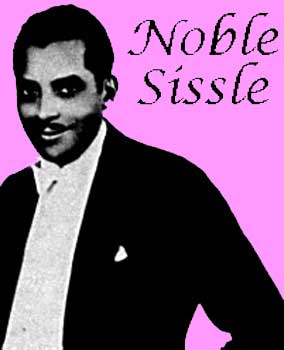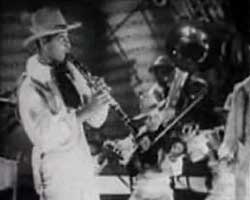 Noble Sissle & His Band provide the music for That's the Spirit (1933), a one-reel musical comedy with considerable imagination, & tremendously fine performances by everyone on board.
Noble Sissle & His Band provide the music for That's the Spirit (1933), a one-reel musical comedy with considerable imagination, & tremendously fine performances by everyone on board.
Sissle's syncopators will perform "St. Louis Blues," "Nobody Knows the Trouble I've Seen," "I've Been Working on the Railroad," "Tiger Rag."
The story framing the performances is supernatural. Comedians Flournoy E. Miller & Mantan Moreland play night watchmen in a haunted pawn shop.
When Miller sits in a chair & it grabs him with his arms (like Chairy in Peewee's Funhouse), that's the cue for Hoagy Carmichael's song "Rocking Chair" to start playing. We don't hear much of that, though; it's given as a mild joke.
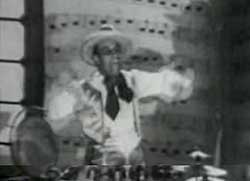 A miniature representation of a band comes to life on a table. Lo & behold, who should it be but a teeny-tiny Noble Sissle & his syncopaters. A miniature representation of a band comes to life on a table. Lo & behold, who should it be but a teeny-tiny Noble Sissle & his syncopaters.
They do a ripping rendition of "Tiger Rag." Fast, spirited, & amazing. Noble's arrangement, puts Buster Bailey out front with clarinet to dominate the number.
"Tiger Rag" is veritable folk-jazz. It's usually ascribed as having been composed collectively by the five white guys of the Original Dixie Land Jazz Band. But to whom is it news that ragtime was never "original" to white guys? They probably learned it from Papa Jack Laine, who in turn learned it from nameless black musicians marching in the streets of New Orleans.
At the time O.D.J.B. claimed composition, New Orleans bands claimed the song had been a standard for a very, very long time under the title "Number Two," with a few of its components added to or amended by Jelly Roll Morton, Punch Morton, & other innovators long before ever it was recorded.
But certainly the Original Dixie Land Jazz Band was first to copyright & record it, in 1917, & it's basic to any ragtime repertoir right down to the present day. Frankly it can be such a chestnut always played pretty much the same way by every band who lays hands to it turning dixieland jazz into music suited only to cartoons & Disney parades.
But that can never be said of Noble Sissle, who in giving that lead to a clarinet allowed Buster Bailey to find something totally new in the standard. With this band it becomes a great piece of music.
There's also some great solo work from the sax & trumpet, while Noble runs back & forth like a madman, commenting excitedly about how good everyone is. Edward Coles doing the tiger growls on tuba is pretty damned cool; but then everyone is.
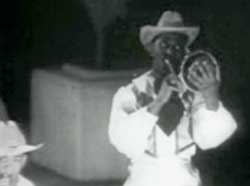 A rowdy exciting performance of W. C. Handy's blues classic "St. Louis Blues" combines with a traditional Negro song from out of North Carolina, dating to slave days, "Nobody Knows the Trouble I've Seen." A rowdy exciting performance of W. C. Handy's blues classic "St. Louis Blues" combines with a traditional Negro song from out of North Carolina, dating to slave days, "Nobody Knows the Trouble I've Seen."
The orchestra dishes these out with brassy ragtime beat, shouts of joy & a couple of the lyrics from "Nobody Knows."
And there's a fine bit of dancing by Noble out front. The drummer, Jack Carter, provides a highly unusual vocal; it's not words, but it takes scatting to a whole other place.
That's Wilbur Paris very exciting on trumbone. He was kind of deprived of the usual trumbone role for "Tiger Rag" which went quite thrillingly to the tuba, but for "St. Louis Blues" he gets to show his mighty stuff.
Both of these latter numbers are rightly categorized as the blues but as Noble Sissle arranges them, they are songs of rebellious gladness, laughing even in the face of misery, oppression, or whatever the damned world can toss at such beauty & talent.
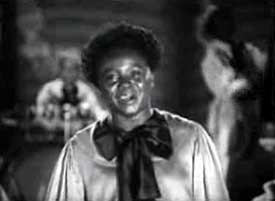 Then Cora La Redd performs, & man oh man is she good; she'll knock your socks off. Then Cora La Redd performs, & man oh man is she good; she'll knock your socks off.
Cora had also sung for the Charlie Dixon Band. She was a big Harlem Renaissance dance star during the 1920s & 30s, the lead dancer & vocalist for the Bandana Babe Peppers.
Noble backs her up she sings "Jig Time." She's a massively thrilling performer with presence & personality galore. When the band takes over for the instrumental, Cora tapdances her heart away. It's absolutely fabulous.
A washboard in the pawnshop springs up & the Washboard Serenaders materialize to perform "In a Shanty in Old Shanty Town" written by Little Jack Little & Joe Young.
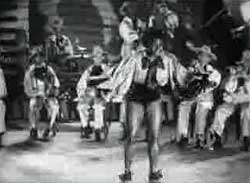 After enjoying these ghostly performances, Miller & Moreland decide it's time for their feets to not fail them now. After enjoying these ghostly performances, Miller & Moreland decide it's time for their feets to not fail them now.
Mantan runs right out of his shoes, & the shoes cry out "Wait for me!" & run after him, a very old gag even in 1933.
The overly sensitive may take exception to the comedy team of Miller & Moreland playing the feets-don't-fail-me stereotype, but I believe Mantan in particular always brought real humor & character to his comedy bits.
Mantan deserves a much more extravagant appreciation than he usually garners. The frame story is cute as the devil & the music is so damned good that this just got to be in the top-ten musical shorts of the 1930s.
copyright © by Paghat the Ratgirl
|
